How to prepare the ginger preserve
1. Wash the ginger thoroughly to remove any traces of mud, wipe with a cloth and gently scrape off the peel/skin. Poke each piece of ginger with a fork or a clean unused hair pin (U pin) – take care not to tear the flesh of very tender ginger. The more you poke the better it will stew in the sugar syrup and taste sweet.
2. Soak the ginger in sufficient water to cover it and keep aside. Change this water twice a day (morning & evening) for two days.
3. On the third day, drain off the water and place the ginger in a pressure cooker and add enough water up to 1 inch above the level of the ginger. Cover the lid, place the weight (whistle) and pressure cook on a full flame till the first whistle goes off. Reduce the flame to sim and continue to cook for another 30 minutes. Turn off the flame, allow the cooker to cool off to room temperature. Open and stir. Keep aside.
4. Place the sugar in a heavy bottomed pan and smash the whole egg into it (along with the shell), mix well and then add the water and stir well. Bring the mixture to a rolling boil, you will notice that the scum (dirt) in the sugar would have floated to the surface. Continue to boil till you are able to see clear liquid below the scum (use a spoon to part the scum). Line a clean bowl with a clean muslin cloth and carefully strain the liquid into it. Discard the scum and transfer the sugar syrup into a large heavy bottomed pan and put it back on the fire and bring it to a boil till it thickens a bit.
5. Add the pressure cooked ginger and simmer for 2 hours, stirring occasionally. If you feel the water has reduced you may add a cup at a time. After two hours check if the ginger is tender and the sugar syrup has penetrated inside each piece, if not, put it back on the fire. If done, add the lime juice, stir and remove from fire and cover with a slotted plate to allow excess heat/steam to escape. When the preserve has completely cooled down, the syrup will thicken.
6. Store in sterilized airtight glass jars/canisters. If prepared hygienically the preserve will last for a year without refrigeration * see note#5
Do follow me on Pinterest, Facebook and Twitter. You can find my videos on YouTube and Instagram. If you’d like to say hello email me on [email protected]. I’d love to hear from you! Liked this recipe? Please comment below! If you try my recipes, do rate them and share a picture on Instagram with the hashtag #ruchikrandhaprecipe and tag me @ruchikrandhap and I will feature your post in my stories!
Printable Recipe
Equipment
- a clean muslin cloth
- a sterilized glass jar/canister (approx 1.5 litres) or multiple smaller glass jars
Ingredients
- 1.1 kg very tender ginger * see note#1
- 1.2 kgs sugar * see note#2
- 2 litres water * see note#3
- 1 egg
- juice of 1 lime
Instructions
- Wash the ginger thoroughly to remove any traces of mud, wipe with a cloth and gently scrape off the peel/skin. Poke each piece of ginger with a fork or a clean unused hair pin (U pin) – take care not to tear the flesh of very tender ginger. The more you poke the better it will stew in the sugar syrup and taste sweet.
- Soak the ginger in sufficient water to cover it and keep aside. Change this water twice a day (morning & evening) for two days.
- On the third day, drain off the water and place the ginger in a pressure cooker and add enough water up to 1 inch above the level of the ginger. Cover the lid, place the weight (whistle) and pressure cook on a full flame till the first whistle goes off. Reduce the flame to sim and continue to cook for another 30 minutes. Turn off the flame, allow the cooker to cool off to room temperature. Open and stir. Keep aside.
- Place the sugar in a heavy bottomed pan and smash the whole egg into it (along with the shell) add the water and stir well. Bring the mixture to a rolling boil, you will notice that the scum (dirt) in the sugar would have floated to the surface. Continue to boil till you are able to see clear liquid below the scum (use a spoon to part the scum). Line a clean bowl with a clean muslin cloth and carefully strain the liquid into it. Discard the scum and transfer the sugar syrup into a large heavy bottomed pan and put it back on the fire and bring it to a boil till it thickens a bit.
- Add the pressure cooked ginger and simmer for 2 hours, stirring occasionally. After two hours check if the ginger is tender and the sugar syrup has penetrated inside each piece, if not, put it back on the fire. If done, add the lime juice, stir and remove from fire and cover with a slotted plate to allow excess heat/steam to escape. When the preserve has completely cooled down, the syrup will thicken.
- Store in sterilized airtight glass jars/canisters. If prepared hygienically the preserve will last for a year without refrigeration * see note#5
Notes
2. For extra sweet sugar syrup increase the sugar by another 200-250 grams.
3. The quantity of water to be used is usually proportionate to the quantities of sugar and ginger, however, it may slightly vary depending on the tenderness of the ginger and the consistency (thickness) of the syrup desired. So keep 1.5 litres of water handy and use only as required.
4. The initial preparation time will be reduced if you have a helping hand to clean the ginger. Cooking time will vary slightly depending on the tenderness of ginger used. Also, each piece of ginger needs to be adequately pricked/poked with a fork – only then will the sugar syrup penetrate the pores and help to stew the pieces properly.
5. Always use a clean dry spoon to remove the ginger preserve.
Disclaimer
The nutritional values are only indicative.
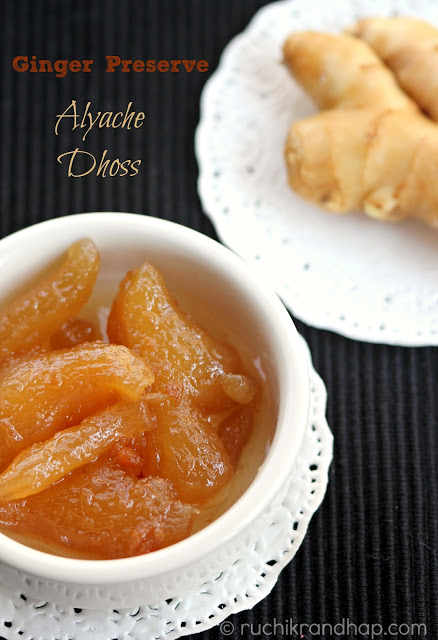

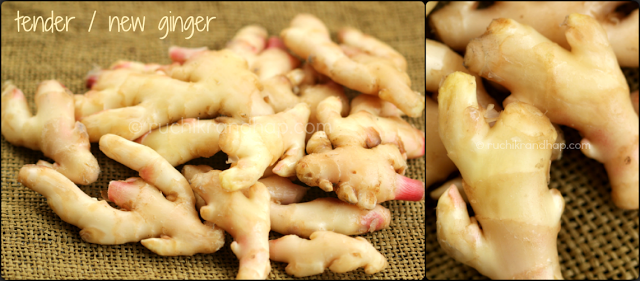
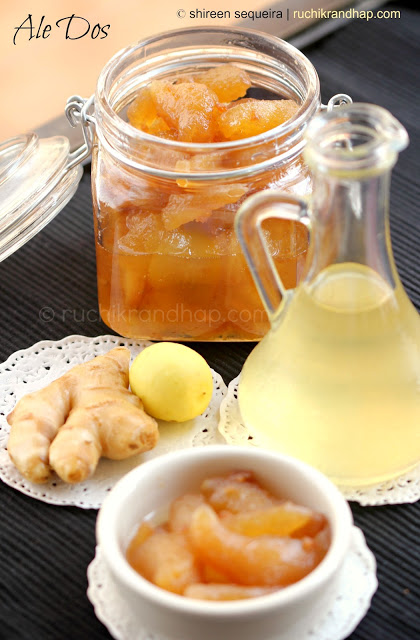
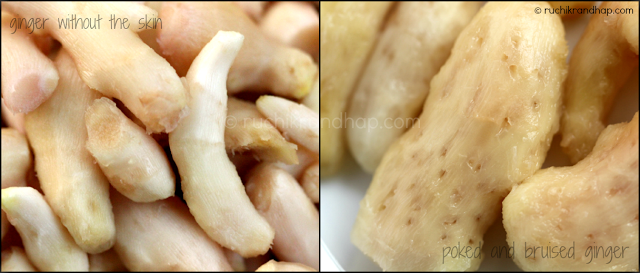

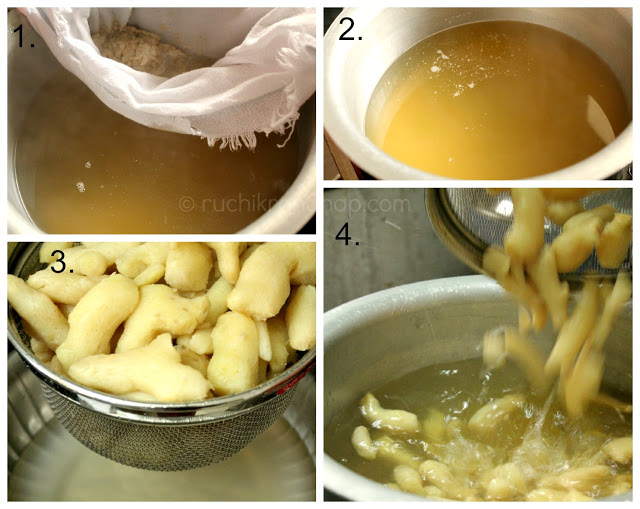
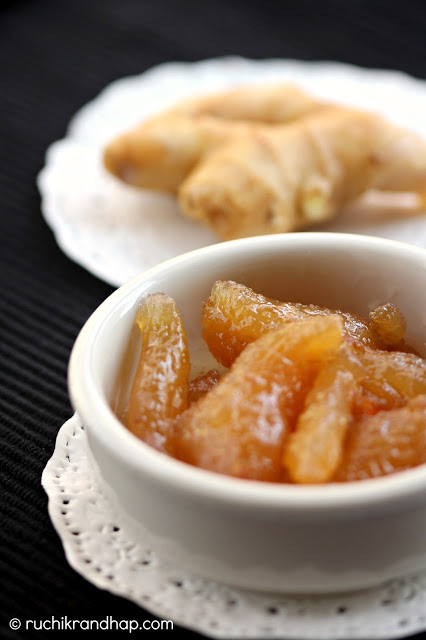
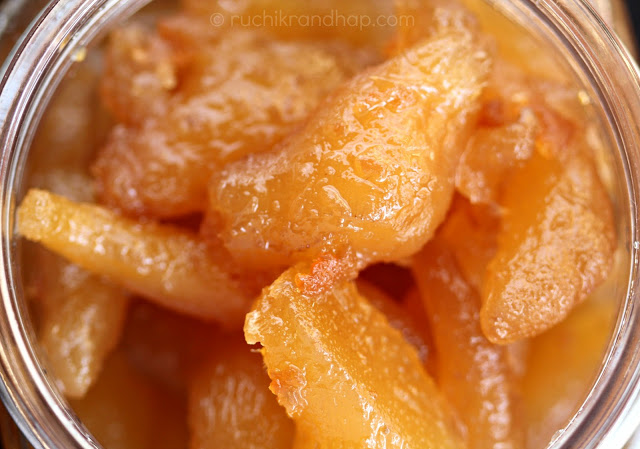
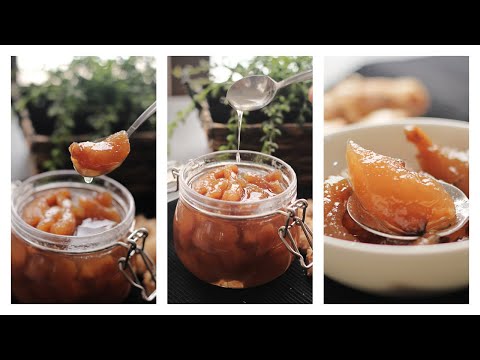
soo tideous work Shireen with so much efforts! and you had all the patience…. I always get my stock from Konkan traders but im sure nothing can beat the one what you make at home.. thanx for the amazing recipe, will surely try my hands when i get a chance
Amazing! memories of home 🙂
Thank God i found you!! I have been wanting to make this since quite awhile. Ginger has so many medicinal properties…and i love ginger in any form. You have an amazing blog here! I will have to make this soon, because right now the ginger is so tender and aromatic. (Thanks for the tips) Mom-in-law, who is no more, used to make some divine ginger doss!
Betsy
looks so yummy! All this long process worth it
Great-secret-of-life.blogspot.com
Looks absolutely divine. Love ginger in any form 🙂
Aparna
I love alyaso dos. Unfortunately we don't get good gonger here, otherwise I would have alreay made my mai's recipe 🙁 That said, I am going to convince my husband to grow ginger in the cold frames he is building for next year… so who knows maybe I'll have my own homemade tender ginger to make into this delicious dos. So many memories of my home are bound up in this delicate preparation.
My favourite…ages since I had this…!
SS what a brilliant recipe to treasure. Love the way you go all out to explain A to Z of your recipe. just a little curious what the purpose of the egg is….
Thanks everyone for your lovely comments!! Michelle, I hope you are able to grow your own ginger soon and make this at home 🙂
DD, thanks so much, the purpose of the egg is to purify the sugar which is with a lot of impurities, in order to get the scum floating to the top, the egg is added..so that when the egg cooks, the scum is easily to scoop out – there is no other way to clarify the sugar otherwise and in the olden days there was no refrigeration and it was imperative that the ingredients used were as sterile as possible so that they would last the whole year on the kitchen shelf
dearest shireen,
how incredible is that. which era are we in.1800, 1900, or 2000s:) such a difficult task and somebody as young as you tried it and was successful as well. mindblowing and hats off to u.
@Anonymous: Hahaha! Thanks so much for bringing a smile on my face 🙂 I am truly touched by your appreciation, it was not very difficult to make this dhoss although I admit it was very time consuming. Poking the ginger was the only part which I didn't enjoy much because my hands began to burn after a while. However, these are dying foods and I think we must keep our tradition alive, and thats what drove me to complete the task!
Hi Shireen,
I m auntie Jessies brother Ben.
I too am a great admiror of her cooking and one of the critic from the days she joined the cooking classes at Nazareth Convent, Balmatta before marrying to Castelino family, so that her dishes turn out to perfection !
I had the opportunity to taste the freshly made dos ( ? yours )at her place last week and it has turned out perfect.
CONGRATULATIONS, KEEP IT UP PUBLISHING TRADITIONAL MANGLOREAN RECIPIES.
Hi Uncle Ben,
Thank you so much for your comment, I am really honoured to read your appreciation. Yes, aunty Jessie is an expert cook and I enjoy the dishes she makes – I have had the good fortune of tasting quite a few in these past years.
The dos that you tasted at her place is the fantastic one that she made. I live in Mumbai and what you see in the pictures is my experiment that I made here, but it turned out almost as good as what she makes.
Thanks for your encouragement, I will keep posting Mangalorean recipes, thanks so much for writing in!
Hey Shireen , this recipe really does bring back memories . I remember my mum went through a 'dos' making phase for a few years when I was growing up ..every evening I would help her poke the ginger . Absolutely love your recipes .. Between your blog and michelle's ( the tiffin box) .. I'm transported back home to mangalore .. Keep 'em coming 😉
Andrea
Hi Andrea! Thanks for the lovely comment, good to know that you have been part of the dos making phase at somepoint of your life…i do hope you can try and make it yourself now, just for old times sake 🙂
Hi Shireen,
I followed all your directions and made the preserve today. It has turned out yum, yum! Actually, to speed up the process i pressure cooked the ginger for the last half hour of cooking in the syrup. I went over other methods/recipes too, but i think your method is simpler and faster without compromising in the taste. Thank you.
Raquelina
Hi Raquelina!! So good to hear that, I think you are one of the few people who have tried this already and reverted so quickly! I am happy to know that it turned out perfect, yes, pressure cooking for longer time is a great idea actually as it greatly reduces the cooking time! Thanks so much for your feedback!
Interesting recipe. I'm a bit confused why the egg shell was included. Wouldn't it be better to discard it?
I'll definitely try this and also add some lime zest along with the lime juice.
Oh how I love this preserve. Holds so many wonderful childhood memories. I remember the special instruments mum used to pierce the ginger – a kind of fork but with much thinner tines. The last bottle of ginger preserve I bought in Mangalore had the ginger cut into bits!! 🙁
Excellent… I googled ale dhoss hoping that google would give me some details so i could explain what i was referring to, to my wife. And i find this elaborate article from you. I could just vaguely remember the name of the dish as i had eaten it ages ago but thanks to you I could show my wife the pics as well
@ Aang: I am not sure why the shell is added, I need to ask my aunt. Will update the post as soon as I get an answer.
@ Susanna: Yes, I have heard of that kind of fork and will post a picture soon! Hope you get to make this someday!
@ Darryl: Thanks so much for your lovely compliment, I hope your wife enjoyed reading this post too!
Thanks for sharing this recipe. I was searching for this recipe, as my dad's Mangalorean friend used to bring him this preserve on visits, in the 1970s. I guess this can also be prepared using honey, substituting for the sugar, in part of full.
@ Sujit: Glad to know that your search for the recipe ends here 🙂 I don't know of a method where honey is used. We always use sugar syrup for this preparation
I have been making the ginger preserve using your recipe..
Since last three years.
It’s coming out great.
Thank you very much for reviving old recipes
Anitha Shetty
Vadodara
Thank you so much for the lovely feedback! So glad to hear that!
Can I do it without the egg in the syrup
Yes you can. It helps purify the sugar though..